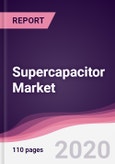What is Supercapacitor Market?
Super capacitors are also known as ultra-capacitors or electrochemical capacitors which utilize high surface area electrode materials and thin electrolytic dielectrics to achieve capacitances several orders of magnitude larger than conventional capacitors. In a conventional capacitor, energy is stored by moving charge carriers and electrons from one metal plate to the other metal. This charge separation creates a potential between the two plates which can be harnessed in an external circuit. The total energy stored in the circuit will increases the amount of charge stored and also increase the potential between the plates.
What are the major applications for Supercapacitor Market?
The major applications of super capacitors includes consumer, public and industrial sectors, medical, aviation, military and transportation. In transportation the super capacitors are used in electric vehicles, trains, buss, trams, lifts, motor racing cars and many more.
Market Research and Market Trends of Supercapacitor Market:
- The present super capacitor are made up of activated carbon which consists of high surface area which limit the capacitors storage capability. To solve this problem the use of activated carbon is being replaced by Graphene. The use of Graphene in supercapacitors is will reduce the high surface area and improve the storage capacity.
- To enhance the storage capacity, the recent developments in super capacitors is using a method that involve coating thin layers of graphene with an oily salt in the super capacitor electrodes. The graphene sheets with an oily salt is separated from one another by the liquid salt which maximize the energy storage capacity.
- In order to increase the energy storage and to reduce the charging cycles in mobile phones, the future trend in super capacitors is using of nano material capacitors which are 100,000 times thinner than a human hair which will also reduce 30,000 charge cycles.
Who are the Major Players in Supercapacitor Market?
The companies referred in the market research report includes Murata Manufacturing Co., Ltd, Maxwell Technologies, Inc., Nesscap Co., Ltd, Nippon Chemi-Con Corporation, Panasonic Corporation (Japan) and more than 10 other companies.
What is our report scope?
The report incorporates in-depth assessment of the competitive landscape, product market sizing, product benchmarking, market trends, product developments, financial analysis, strategic analysis and so on to gauge the impact forces and potential opportunities of the market. Apart from this the report also includes a study of major developments in the market such as product launches, agreements, acquisitions, collaborations, mergers and so on to comprehend the prevailing market dynamics at present and its impact during the forecast period 2020-2025.
Key Takeaways from this Report
- Evaluate market potential through analyzing growth rates (CAGR %), Volume (Units) and Value ($M) data given at country level – for product types, end use applications and by different industry verticals.
- Understand the different dynamics influencing the market – key driving factors, challenges and hidden opportunities.
- Get in-depth insights on your competitor performance – market shares, strategies, financial benchmarking, product benchmarking, SWOT and more.
- Analyze the sales and distribution channels across key geographies to improve top-line revenues.
- Understand the industry supply chain with a deep-dive on the value augmentation at each step, in order to optimize value and bring efficiencies in your processes.
- Get a quick outlook on the market entropy – M&A’s, deals, partnerships, product launches of all key players for the past 4 years.
- Evaluate the supply-demand gaps, import-export statistics and regulatory landscape for more than top 20 countries globally for the market.
Table of Contents
Methodology

LOADING...








